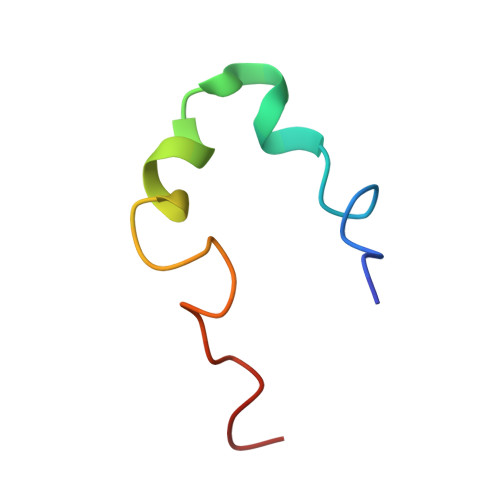Driving forces in the delivery of penetratin conjugated G protein fragment.
Albrizio, S., Giusti, L., D'Errico, G., Esposito, C., Porchia, F., Caliendo, G., Novellino, E., Mazzoni, M.R., Rovero, P., D'Ursi, A.M.(2007) J Med Chem 50: 1458-1464
- PubMed: 17348636
- DOI: https://doi.org/10.1021/jm060935b
- Primary Citation of Related Structures:
2NZZ, 2O00 - PubMed Abstract:
A42 is a chimera peptide consisting of Galphas(374-394)C379A--the 21-mer C terminus of the Galphas protein, able of adenosine inhibitory activity--and penetratin--the 16 residue fragment, derived from the homeodomain of the Drosophila transcription factor Antennapedia. A42 is able to cross cell membranes and to inhibit A2A and A2B adenosine and beta-adrenergic receptor stimulated camps (D'Ursi et al. Mol. Pharmacol. 2006, 69, 727-36). Here we present an extensive biophysical study of A42 in different membrane mimetics, with the objective to evaluate the molecular mechanisms which promote the membrane permeation. Fluorescence, CD, and NMR data were acquired in the presence of negatively charged and zwitterionic sodium dodecyl sulfate and dodecylphosphocholine surfactants. To validate the spectroscopic results in a larger scale, fluorescence microscopy experiments were performed on negatively charged and zwitterionic dipalmitoylphosphatidylglycerol and dipalmitoylphosphatidylcholine vesicles. Our results show that the internalization of A42 is mainly driven by electrostatic interactions, hydrophobic interactions playing only a secondary, sinergistic role. The distribution of the charges along the molecule has an important role, highlighting that internalization is a process which requires a specific matching of peptide and membrane properties.
Organizational Affiliation:
Department of Chemistry, University of Naples Federico II, I-80131 Naples, Italy.














